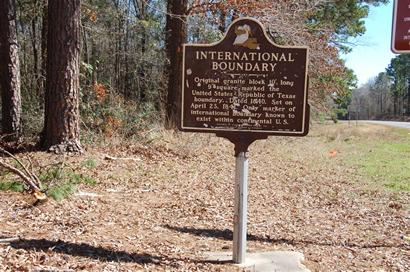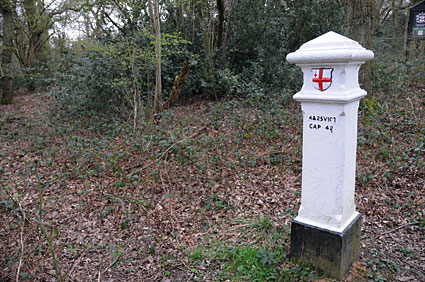Boundary marker
A landmark (including demarcation, landmark or Bannstein ) is a common identification of boundary points ( corner points, inflection points or nodes ) of a parcel boundary. Landmarks are visible to the local marking, but at ground level in these border point, usually with a mean positional accuracy of a few centimeters. In field and forest boundaries but they can also stand a few feet from the ground to be clearly visible to farmers while he was plowing (in this case stones are usually longer than usual used). In very long borders formerly known as stretchers were placed (usually every 100 m).
Indirect labeling
If you can not identify a boundary point directly, a limit signs can also be set as an indirect or indirect demarcation in one of the outgoing from the boundary point limits ( at a short distance, such as a meter). At state borders, a wise man also display a more distant boundary point about because of overbuilding, on river banks and in the mountain region.
Original boundary stones
In difficult terrain and conditions Terms original demarcation solutions devised will:
- Football pitch hose in Wiechs: border Germany / Switzerland on the sidelines of the football field is marked by a stone slab at ground level.
- Railroad track Sing - Schaffhausen: border Germany / Switzerland is characterized by a walk- in plate railway ballast.
- Rhine midway between exclave Biisingen and Switzerland is documented by an invisible boulder in the middle of the Rhine.
Nature
Boundary stones are usually made of granite or cement stones with a cross on the top, older Abmarkungen can also be hewn or unhewn boulders without the cross. There are also boundary stones on which no cross, but the actual border line is displayed. For corner or inflection points as well as angled lines can be found on some boundary nodes also stylized border line profiles in the form of a "T". The available in the region rock types were used. There are those made of granite, limestone, marble, sandstone, slate, basalt columns and other species. When limits in alpine terrain, the boundary markers (crosses, lines, coat of arms and years ) were often carved as rocky March in the bedrock or in individual standing, large rocks.
At the boundaries of estates or stately forests, there are numerous historical, artistically executed landmarks with coat of arms or inscriptions. Boundary stones were set to mark as church land.
Modern forms
Instead landmarks are - (depending on the state - dependent measurement regulations as well as in Germany ) depending on local conditions - use other Vermarkungsarten. In urban or built-up area, these are mainly: Grenzmarke with screw thread tube with plastic cap, Meisselkreuz, steel or brass nail pin, mostly with inscription " limit point ". In recent times, partly also come landmarks of plastic used. Prior to the conclusion of an ongoing survey also tentative signs (days brands) such as wooden pegs or rods (also ranging poles ) in use.
Landmarks may be provided with so-called " underground fuses ", " Untervermarkungen " or "witness ", which consists for example of a with the neck downward glass bottle, clay cone or a conical plastic brand ( carrot ) under the landmark. In many regions Tonzeugen were used. These are usually rectangular or triangular clay disks with the coat of arms of the district on it. These witnesses should in important limits recovery permit or attest to the accuracy of the boundary stone, if the stone is torn by the plow, for example. For higher accuracy requirements, the witness can be abgelotet with the theodolite or a batter.
Legal regulations
In Germany, under the Criminal Code removing, defacing or moving a landmark in the intent of causing another disadvantage, punishable by a fine or imprisonment of up to five years. The unauthorized modification or removal of boundary markers also prepared according to the surveying and cadastral laws of the states a misdemeanor dar.
Photos of modern boundary markers
Boundary markers made of plastic with a hole and label
Modern Grenzabmarkungen - border between Thuringia and Saxony in Windischleuba
Modern state border marker - border between Germany and Poland at Frankfurt ( Oder) on Ziegenwerder
Frontier post in Baarle
Baarle: Paving boundary stones next to a sidewalk cafe
Baarle: Paving Landmarks - the border runs through a house
Photos of historic boundary markers
Rock March 1584 between the District Court and the Tölz Benediktbeuern on Langeneck above Jachenau
Landmark of Hersfeld Abbey in Vacha
Landmark between Lauffen and Kirchheim am Neckar
Forest district boundary and municipal boundary in the Dippoldiswalder Heide ( Saxony)
Electorate of Saxony landmark Oberlößnitz with an electoral hat
Landmark on the historic border between Bohemia and Bavaria in Nový Zdar / New fire
Landmark between Altona and Hamburg from 1896
Historic Landmark between Duchy of Styria and Archduchy Austria below the Enns
Landmark between two communities in Jersey
Landmark between two communities on Guernsey
Witness of St. Blaise
Historical landmarks in the Swiss Customs Museum
Historical landmark south of Calvörde
Landmark from the First World War between the circles Hildburghausen and Meiningen on the road between Wolfmannshausen and Queienfeld
Landmark with coat of arms of the Princely House of Fürstenberg ( 1767)
Landmark between the principality of Lippe and the Free State of Prussia in Desert Pehlen
Landmark between the principality of Lippe and the Free State of Prussia on the road from deserts to Vlotho
Landmark in Rohrbach (Saar)
Historical landmark of the country Hege the Free Imperial City of Rothenburg ob der Tauber
Border cross between Badorf and Schwadorf
Landmark between the County of Rietberg and the Prince-Bishopric of Paderborn from 1756
Landmark in the triangle on the Darß, E. of Zingst
Demarcation at border triangle of Burgenland, Lower Austria and Styria in the villages Willers gorge
Limit mark on the border of Brazil, Guyana and Venezuela on Mount Roraima
Examples of historical landmarks
- Dreiherrenstein
- Triangular pile
- GDR border pillar
- Lapidary Willrode










